Joan Kron, the legendary author, journalist, and recent filmmaker has long been known as the “queen of plastic surgery.” Her wit, integrity, and personal quest for truth-telling has led her to become both loved and feared among those in the industry. Her desire to empower those within the field, both the patients involved with treatments, as well as the push for ethical practices among physicians, has cemented her reputation as the the most powerful voice on the subject.
Kron aims to bring her wealth of knowledge, as well as her balanced approach to the industry, to a new readership.
Tell us a bit about your background, how did you become a journalist: I was trained to be a theatrical costume designer. I didn’t start writing until I was 41. I fell into journalism. I’m a born and bred New Yorker. I attended Carnegie Mellon University in Pittsburgh for one year and then transferred to a Masters Degree program in theatrical design at the Yale School of Drama.
After working off-Broadway and at NBC TV, I married a general surgeon, and moved to Philadelphia, had two kids, worked as an interior designer and helped found the Arts Council of the YMHA—and eventually became the chairman. We shook up a very staid city in the 1960s by bringing avant garde events in all the arts. During those years I also produced—with a friend—a number of limited edition art objects by Roy Lichtenstein, Robert Indiana and Andy Warhol. For a brief period, my husband and I created and published a city magazine –that failed for lack of funding, but I learned every aspect of the magazine business—ad sales, circulation, production—except writing. Meanwhile my husband volunteered for a few months each year on The Hope ship run by Project Hope in Third World countries. In 1968, we went as a family with the ship to Ceylon—now Sri Lanka. Sadly, my 16-year old daughter died there from a severe infection.
Grieving and unsure of what to do with my life, I was saved by three Penn graduates who asked me to be the society editor of an underground newspaper they were starting. I said I couldn’t write. Lee Eisenberg, who went on to be the editor of Esquire, said “everyone can write.” So I tried it. My first story was about a hash harvest in one of the city’s best zip codes. I discovered I could write, but the underground paper lost its backers so I submitted the story to Philadelphia magazine and the rest is history. Alan Halpern, the editor, liked it, discouraged me from going to journalism school and taught me everything I needed to know. The publisher wanted me to write decorating so he could sell furniture ads. I complained that I didn’t want to write frivolous stories and Alan said, the things you call frivolous are what people care about. It was up to me to find the seriousness in the subject.
My first decorating story, “Mayor Rizzo Builds His Dream House,” led to the ex-police chief not moving into his mansion. There were questions about how he could afford it. That taught me that decorating stories could be substantive. Meanwhile, to help myself, I began writing about grief therapy—the new death and dying movement—thanatology.
In 1971, after a divorce I moved back to New York, married my high school sweetheart, joined New York magazine where I stayed until Rupert Murdoch got control of it. I quit and went immediately to The New York Times where they were starting The Home Section. I quit the Times to finish a design book I was writing with Suzanne Slesin called High-Tech. After another book, Home-Psych, about the social psychology of home and decoration, I moved to the Wall Street Journal as the front page fashion reporter. Two years later, I became editor-in-chief of Avenue, a magazine for New York’s one percent. In 1990, I joined a start-up called Allure.
How did you start writing about plastic surgery? I was hired by the editor, Linda Wells, to write the psychology of beauty but fell into plastic surgery when Linda wanted a story about shopping for a new face. I ended up getting a facelift—the magazine did not pay for it, I did. And I realized that plastic surgery was going to be huge and no one was covering it at any publication. I proposed that I take on the beat and Linda agreed. I soon learned I had one attribute that made me suited for the job. I don’t faint at the sight of blood.
At Allure, we never wrote a piece that didn’t say what the complications were, nothing was ever all good or all bad. I had the good luck, or good sense, to put one surgeon out of business and close down some chains pushing dangerous fat-busting injections.
What have you learned while covering plastic surgery? No matter how much is written, the public has many misconceptions about what can and can’t be accomplished. There are so many old wives tales. My mother once told me I couldn’t have eyelid surgery because I scar badly. She was thinking about a childhood scar on my leg. What she didn’t know is that the face heals differently than the arms, legs and back. Because of misinformation, many people who could benefit refuse to take advantage of treatments that could make their lives better.
Another group needs to be held back. They want to be the first for every treatment. I’ve seen too many things that sound good, and turn out not to be. While writing about what’s new, I also advocate caution. I know that every time I write about a treatment I am putting someone on the operating table or in the treatment chair. That’s a heavy burden.
How do the doctors and the pharma companies feel about you? I’m told I’m loved and feared. That’s fine with me.
Why did you leave Allure? At the end of last year, Linda was replaced and most of the contributing editors, including myself, were unrenewed. I was told it was a budget issue. That gave me more time to work on my movie.
How did you get into film? I became interested in film after being a talking head in someone else’s documentary about plastic surgery. I thought to myself, I can do that. My film, Take My Nose …Please! is based on a paragraph in my 1990 book Lift: Wanting Fearing and Having a Facelift, that described how comedians historically are the only celebrities who are honest about their plastic surgery. For these women, cosmetic treatments aren’t vanity—they’re affirmative action for the unfair distribution of beauty and youthfulness. Rather than oppressing women, these treatments can liberate them—it’s not a popular notion, but one I believe.
Do you believe there’s a lack of integrity in the practice of journalism these days, primarily within print media, and why? I think it’s sad that we get information from people who are paid to write good reviews—but the journalists I know have not lost their integrity.
With the major shifts at Allure, and other magazines, what do you believe the industry is moving towards? I’m no expert on this subject, but no company can exist for long if it’s losing money. Magazine companies have to cut costs or find new sources of revenue. As everyone knows, we are in a period of disruption, caused by amazing advances in technology. Lapsed subscribers are getting their news online. My book High-Tech popularized the term high-tech. High-tech is changing the world. Maybe I should take part of the blame.
Sometimes known to be controversial, where do you believe your willingness to tell the truth has served you well, as both a journalist, and within the realm of plastic surgery? Several years ago, I did a piece online about a study that found a tiny percentage (30 suspected cases, at that time, out of millions) of people who had implants had developed a very rare kind of lymphona that was rarely fatal—now called, Breast Implant-Associated Anaplastic Large Cell Lymphoma (BIA-ALCL). The FDA has information about it on its website. The story had to be balanced or it could start a stampede to remove implants. You don’t want to sensationalize the news. In that case, my job was to put the news in perspective.
What are you hoping to accomplish by joining the LVBX team? I like to write about the intersection of science and culture. For instance, why are we having shots of, say, Botox Cosmetic? A frown line is not a medical condition. Botox is a temporary treatment for a social condition called aging—and when one is perceived as aging, fair or not, it can affect one’s livelihood and personal relationships.










